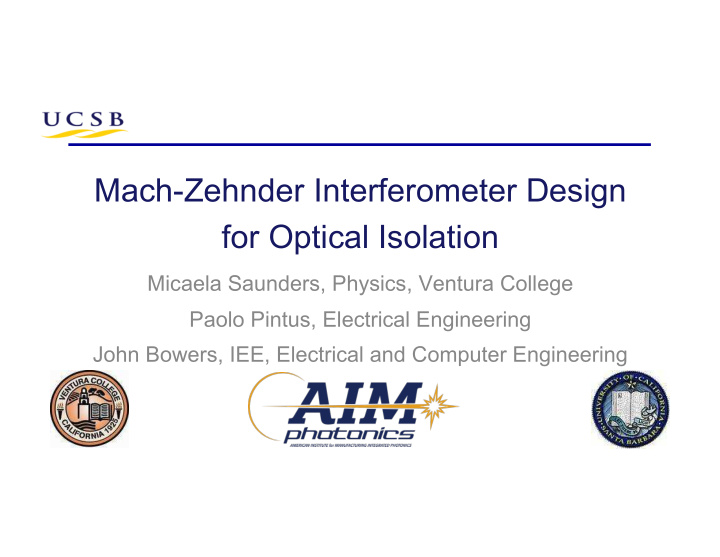



Mach-Zehnder Interferometer Design for Optical Isolation Micaela Saunders, Physics, Ventura College Paolo Pintus, Electrical Engineering John Bowers, IEE, Electrical and Computer Engineering
Communication by Light 2016: What happens in an Internet Minute? www.excelacom.com/resources/.../ 2016 -update- what-happens -in-one- internet - minute 2.4 Million Search Queries Future communication 69,444 Hours Watched technology must include: • More data transmission $203,569 In Sales • Low power consumption • Faster communication
Integrating Photonics • Combine many device functions on a single chip – Small size – Large volume of production – Low cost – Low energy use
Mach-Zehnder Interferometer Design Optical Isolators • What is an optical isolator? – Light CAN propagate in the forward direction – Light CANNOT propagate in the backward direction • Why is it important? – Avoid back-reflection out a laser cavity • Which material for an isolator? – We need a nonreciprocal material (e.g. Ce:YIG) http://www.nature.com/nphoton/journal/v7/n8/fig_tab/nphoton.2013.185_F2.html
MZI Modeling http://beamware.at/ 1. Find an equation to describe light propagation through a MZI 2. Implement model into Matlab 3. Engineer the length of two waveguide arms
Ideal Case L1 = 327.06 µm L2 = 327.89 µm
Fabricated Device L1 = 327.06 µm L2 = 347.89 µm
Optical Isolator – Robust Design Isolation at 1550 nm : • Due to fabrication inaccuracy , the device might not work correctly ( spectral shift ) • We want a device with low sensitivity to fabrication error → robust design
Optimization for Spectral Shift • Previously we found the solution – L1 = 327.06 µ m – L2 = 327.89 µ m • However, multiple solutions exist – L1 = 327.06 µ m + (m + n)*0.175 µ m + (n - m)*655.96 µ m – L2 = 327.89 µ m - (m + n)*0.175 µ m + (n - m)*655.96 µ m Where (n , m) integers of resonance Where is the minimal shift? What is n and m?
Waveguide Cross-Section • h Si is the silicon thickness, nominal value 220nm • w Si is the silicon waveguide width nominal value 600nm h Si • L1 : Length arm 1 Si • L2 : Length arm 2 w Si L2 L1
Shift Caused by Error of 1 nm n m L1 ( µ m) L2 ( µ m) Δλ (nm) w Si Δλ (nm) h Si 0 0 327.06 327.89 -0.456 -0.659 Solution Not a solution 0 1 -327.71 -328.24 X X 0 -1 983.85 984.02 0.761 3.897 -1 -1 327.71 328.24 0.301 2.202 Solution -1 0 328.07 327.89 -0.456 -0.659 1 1 328.41 327.54 0.1 1.426
Steps for Optimization • Modeling a MZI for optical isolation (Math/Physics) • Implementing the model in Matlab (Coding) • Simulating a MZI (Analysis) • Design a robust MZI (Synthesis) • What happens if we change the optical length of the arm? • Modify to have a more robust design (e.g., thermal control)
Acknowledgements Paolo Pintus John Bowers Wendy Ibsen
1550 nm
Reflections
Recommend
More recommend